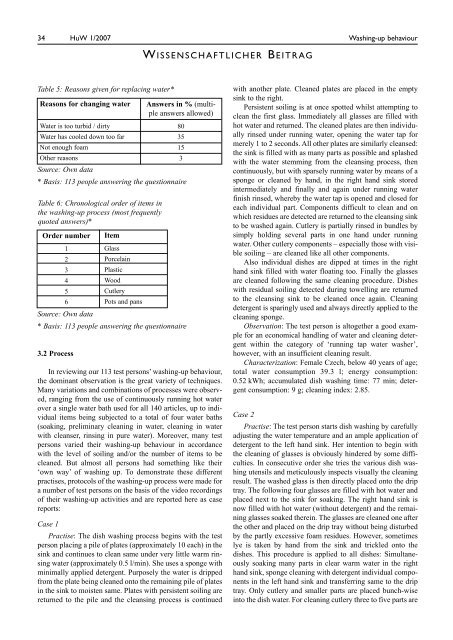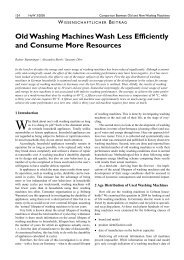Washing-up Behaviour and Techniques in Europe - Institute of ...
Washing-up Behaviour and Techniques in Europe - Institute of ...
Washing-up Behaviour and Techniques in Europe - Institute of ...
You also want an ePaper? Increase the reach of your titles
YUMPU automatically turns print PDFs into web optimized ePapers that Google loves.
031_Stamm<strong>in</strong>ger.qxp 27.02.2007 16:26 Seite 34<br />
34 HuW 1/2007 <strong>Wash<strong>in</strong>g</strong>-<strong>up</strong> behaviour<br />
Table 5: Reasons given for replac<strong>in</strong>g water*<br />
Reasons for chang<strong>in</strong>g water<br />
Water is too turbid / dirty<br />
Water has cooled down too far<br />
Not enough foam<br />
Other reasons<br />
3.2 Process<br />
In review<strong>in</strong>g our 113 test persons’ wash<strong>in</strong>g-<strong>up</strong> behaviour,<br />
the dom<strong>in</strong>ant observation is the great variety <strong>of</strong> techniques.<br />
Many variations <strong>and</strong> comb<strong>in</strong>ations <strong>of</strong> processes were observed,<br />
rang<strong>in</strong>g from the use <strong>of</strong> cont<strong>in</strong>uously runn<strong>in</strong>g hot water<br />
over a s<strong>in</strong>gle water bath used for all 140 articles, <strong>up</strong> to <strong>in</strong>dividual<br />
items be<strong>in</strong>g subjected to a total <strong>of</strong> four water baths<br />
(soak<strong>in</strong>g, prelim<strong>in</strong>ary clean<strong>in</strong>g <strong>in</strong> water, clean<strong>in</strong>g <strong>in</strong> water<br />
with cleanser, r<strong>in</strong>s<strong>in</strong>g <strong>in</strong> pure water). Moreover, many test<br />
persons varied their wash<strong>in</strong>g-<strong>up</strong> behaviour <strong>in</strong> accordance<br />
with the level <strong>of</strong> soil<strong>in</strong>g <strong>and</strong>/or the number <strong>of</strong> items to be<br />
cleaned. But almost all persons had someth<strong>in</strong>g like their<br />
‘own way’ <strong>of</strong> wash<strong>in</strong>g <strong>up</strong>. To demonstrate these different<br />
practises, protocols <strong>of</strong> the wash<strong>in</strong>g-<strong>up</strong> process were made for<br />
a number <strong>of</strong> test persons on the basis <strong>of</strong> the video record<strong>in</strong>gs<br />
<strong>of</strong> their wash<strong>in</strong>g-<strong>up</strong> activities <strong>and</strong> are reported here as case<br />
reports:<br />
Case 1<br />
Practise: The dish wash<strong>in</strong>g process beg<strong>in</strong>s with the test<br />
person plac<strong>in</strong>g a pile <strong>of</strong> plates (approximately 10 each) <strong>in</strong> the<br />
s<strong>in</strong>k <strong>and</strong> cont<strong>in</strong>ues to clean same under very little warm r<strong>in</strong>s<strong>in</strong>g<br />
water (approximately 0.5 l/m<strong>in</strong>). She uses a sponge with<br />
m<strong>in</strong>imally applied detergent. Purposely the water is dripped<br />
from the plate be<strong>in</strong>g cleaned onto the rema<strong>in</strong><strong>in</strong>g pile <strong>of</strong> plates<br />
<strong>in</strong> the s<strong>in</strong>k to moisten same. Plates with persistent soil<strong>in</strong>g are<br />
returned to the pile <strong>and</strong> the cleans<strong>in</strong>g process is cont<strong>in</strong>ued<br />
W ISSENSCHAFTLICHER B EITRAG<br />
Answers <strong>in</strong> % (multiple<br />
answers allowed)<br />
80<br />
35<br />
15<br />
3<br />
Source: Own data<br />
* Basis: 113 people answer<strong>in</strong>g the questionnaire<br />
Table 6: Chronological order <strong>of</strong> items <strong>in</strong><br />
the wash<strong>in</strong>g-<strong>up</strong> process (most frequently<br />
quoted answers)*<br />
Order number<br />
1<br />
2<br />
3<br />
4<br />
5<br />
6<br />
Item<br />
Glass<br />
Porcela<strong>in</strong><br />
Plastic<br />
Wood<br />
Cutlery<br />
Pots <strong>and</strong> pans<br />
Source: Own data<br />
* Basis: 113 people answer<strong>in</strong>g the questionnaire<br />
with another plate. Cleaned plates are placed <strong>in</strong> the empty<br />
s<strong>in</strong>k to the right.<br />
Persistent soil<strong>in</strong>g is at once spotted whilst attempt<strong>in</strong>g to<br />
clean the first glass. Immediately all glasses are filled with<br />
hot water <strong>and</strong> returned. The cleaned plates are then <strong>in</strong>dividually<br />
r<strong>in</strong>sed under runn<strong>in</strong>g water, open<strong>in</strong>g the water tap for<br />
merely 1 to 2 seconds. All other plates are similarly cleansed:<br />
the s<strong>in</strong>k is filled with as many parts as possible <strong>and</strong> splashed<br />
with the water stemm<strong>in</strong>g from the cleans<strong>in</strong>g process, then<br />
cont<strong>in</strong>uously, but with sparsely runn<strong>in</strong>g water by means <strong>of</strong> a<br />
sponge or cleaned by h<strong>and</strong>, <strong>in</strong> the right h<strong>and</strong> s<strong>in</strong>k stored<br />
<strong>in</strong>termediately <strong>and</strong> f<strong>in</strong>ally <strong>and</strong> aga<strong>in</strong> under runn<strong>in</strong>g water<br />
f<strong>in</strong>ish r<strong>in</strong>sed, whereby the water tap is opened <strong>and</strong> closed for<br />
each <strong>in</strong>dividual part. Components difficult to clean <strong>and</strong> on<br />
which residues are detected are returned to the cleans<strong>in</strong>g s<strong>in</strong>k<br />
to be washed aga<strong>in</strong>. Cutlery is partially r<strong>in</strong>sed <strong>in</strong> bundles by<br />
simply hold<strong>in</strong>g several parts <strong>in</strong> one h<strong>and</strong> under runn<strong>in</strong>g<br />
water. Other cutlery components – especially those with visible<br />
soil<strong>in</strong>g – are cleaned like all other components.<br />
Also <strong>in</strong>dividual dishes are dipped at times <strong>in</strong> the right<br />
h<strong>and</strong> s<strong>in</strong>k filled with water float<strong>in</strong>g too. F<strong>in</strong>ally the glasses<br />
are cleaned follow<strong>in</strong>g the same clean<strong>in</strong>g procedure. Dishes<br />
with residual soil<strong>in</strong>g detected dur<strong>in</strong>g towell<strong>in</strong>g are returned<br />
to the cleans<strong>in</strong>g s<strong>in</strong>k to be cleaned once aga<strong>in</strong>. Clean<strong>in</strong>g<br />
detergent is spar<strong>in</strong>gly used <strong>and</strong> always directly applied to the<br />
clean<strong>in</strong>g sponge.<br />
Observation: The test person is altogether a good example<br />
for an economical h<strong>and</strong>l<strong>in</strong>g <strong>of</strong> water <strong>and</strong> clean<strong>in</strong>g detergent<br />
with<strong>in</strong> the category <strong>of</strong> ‘runn<strong>in</strong>g tap water washer’,<br />
however, with an <strong>in</strong>sufficient clean<strong>in</strong>g result.<br />
Characterization: Female Czech, below 40 years <strong>of</strong> age;<br />
total water consumption 39.3 l; energy consumption:<br />
0.52 kWh; accumulated dish wash<strong>in</strong>g time: 77 m<strong>in</strong>; detergent<br />
consumption: 9 g; clean<strong>in</strong>g <strong>in</strong>dex: 2.85.<br />
Case 2<br />
Practise: The test person starts dish wash<strong>in</strong>g by carefully<br />
adjust<strong>in</strong>g the water temperature <strong>and</strong> an ample application <strong>of</strong><br />
detergent to the left h<strong>and</strong> s<strong>in</strong>k. Her <strong>in</strong>tention to beg<strong>in</strong> with<br />
the clean<strong>in</strong>g <strong>of</strong> glasses is obviously h<strong>in</strong>dered by some difficulties.<br />
In consecutive order she tries the various dish wash<strong>in</strong>g<br />
utensils <strong>and</strong> meticulously <strong>in</strong>spects visually the clean<strong>in</strong>g<br />
result. The washed glass is then directly placed onto the drip<br />
tray. The follow<strong>in</strong>g four glasses are filled with hot water <strong>and</strong><br />
placed next to the s<strong>in</strong>k for soak<strong>in</strong>g. The right h<strong>and</strong> s<strong>in</strong>k is<br />
now filled with hot water (without detergent) <strong>and</strong> the rema<strong>in</strong><strong>in</strong>g<br />
glasses soaked there<strong>in</strong>. The glasses are cleaned one after<br />
the other <strong>and</strong> placed on the drip tray without be<strong>in</strong>g disturbed<br />
by the partly excessive foam residues. However, sometimes<br />
lye is taken by h<strong>and</strong> from the s<strong>in</strong>k <strong>and</strong> trickled onto the<br />
dishes. This procedure is applied to all dishes: Simultaneously<br />
soak<strong>in</strong>g many parts <strong>in</strong> clear warm water <strong>in</strong> the right<br />
h<strong>and</strong> s<strong>in</strong>k, sponge clean<strong>in</strong>g with detergent <strong>in</strong>dividual components<br />
<strong>in</strong> the left h<strong>and</strong> s<strong>in</strong>k <strong>and</strong> transferr<strong>in</strong>g same to the drip<br />
tray. Only cutlery <strong>and</strong> smaller parts are placed bunch-wise<br />
<strong>in</strong>to the dish water. For clean<strong>in</strong>g cutlery three to five parts are





